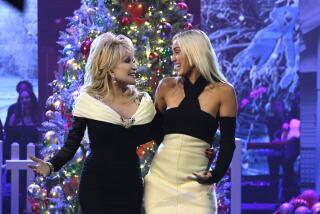A season for selling Festivus poles
- Share via
MILWAUKEE — Kevin Campanella hates buying and receiving Christmas presents that he says inevitably disappoint. This year, no such worries.
Campanella plans to seek “serenity now” by celebrating Festivus, a wacky holiday popularized in a 1997 “Seinfeld” episode. Billed as “Festivus for the rest of us,” the holiday celebrated by the Costanza clan on Dec. 23 features an airing of grievances and feats of strength in which a guest must pin the host before the party ends.
In protest of Christmas’ commercialism, character Frank Costanza puts up an unadorned aluminum pole instead of a tree. The metal, he says admiringly, has a “very high strength-to-weight ratio.”
“I just always loved that episode,” said Campanella, 28, a landscaper from Warwick, R.I. “But it’s not so much about the show -- I think the idea of Festivus is a good idea.”
So does the Wagner Companies. The Milwaukee-based maker of hand-railing components is bringing back its line of Festivus poles for the holiday season. The company had plenty of metal rails on hand already and launched the product last year on a whim.
“We did it mainly as a lark. We never looked at it as a tremendous moneymaking scheme,” said Tony Leto, the firm’s executive vice president of sales and marketing. “But in many ways, Festivus is taking on a life of its own.”
Wagner, which made $15 million last year from products including handrail brackets and pipe elbows, earned only a few thousand dollars from Festivus pole sales.
Leto said the company received some media publicity upon launch of the poles, but he credits bloggers with strong “Seinfeld” loyalties for spreading the news far and wide.
Wagner sold about 250 poles in 2005, with around 100 sales coming from the firm’s 120 employees. This season, it sold about 300 poles by mid-December and was on pace to sell twice that number by Saturday, said Leto, whose claim to fame is that he shared a drama class with Jerry Seinfeld at Queens College in New York.
Wagner offers a 6-foot Festivus pole for $38 and a 2-foot-8-inch tabletop model for $30. The setup is simple: a hollow pipe, 1.9 inches in diameter, inserted into a collapsible aluminum base.
Wisconsin Gov. Jim Doyle, a “Seinfeld” fanatic who claims to have seen every episode eight times, proudly displayed one of the company’s poles last year at the governor’s mansion in Madison. But Doyle said he will donate the pole to the Wisconsin Historical Museum after reports that “Seinfeld” co-star Michael Richards used racial slurs during a stand-up comedy routine last month.
Leto said he hoped the Richards incident wouldn’t affect his company’s sales.
“Fans know it was a Costanza holiday, not a Kramer holiday,” he said, referring to characters played by Jerry Stiller and Richards. “Anyway, Kramer eventually rejects the holiday at the end of the episode.”
Gabriel Morales, 32, of Atlanta said Richards’ tirade didn’t keep him from ordering a Festivus pole this month.
“You know, people make mistakes, they say stupid things,” said Morales, an information technology analyst who held his Festivus party early this year to coincide with a monthly dinner club. “No one at the party really cared about that either.”
The “Seinfeld” Festivus episode developed from series writer Dan O’Keefe’s childhood experiences. His father invented the holiday in the 1960s.
“As a kid, we’d come home and there’d be weird decorations,” said the 30-something O’Keefe. “There was the playing of strange German and Italian pop music from the ‘50s. And the airing of grievances was a real thing.”
Wagner’s Leto acknowledged the irony of making money off a holiday that celebrates anti-commercialism. But the company is having too much fun with the holiday to stop now, he said.
O’Keefe doesn’t begrudge Wagner’s commercial efforts.
“It sounds to me like they’re making a good living -- good for them,” O’Keefe said.
More to Read
The biggest entertainment stories
Get our big stories about Hollywood, film, television, music, arts, culture and more right in your inbox as soon as they publish.
You may occasionally receive promotional content from the Los Angeles Times.










